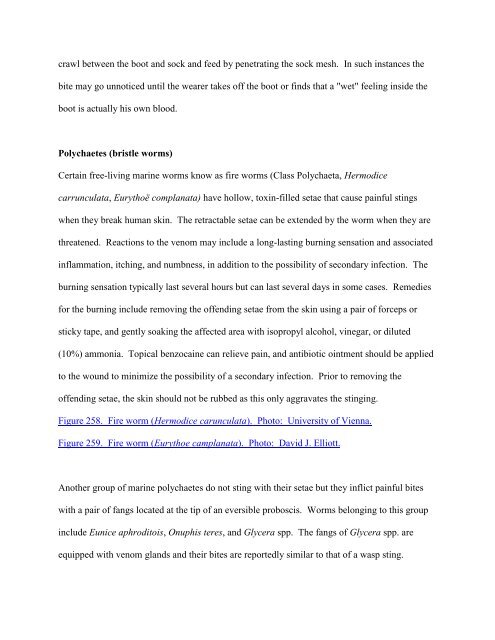Field Guide to Venomous and Medically Important Invertebrates ...
Field Guide to Venomous and Medically Important Invertebrates ...
Field Guide to Venomous and Medically Important Invertebrates ...
You also want an ePaper? Increase the reach of your titles
YUMPU automatically turns print PDFs into web optimized ePapers that Google loves.
crawl between the boot <strong>and</strong> sock <strong>and</strong> feed by penetrating the sock mesh. In such instances the<br />
bite may go unnoticed until the wearer takes off the boot or finds that a "wet" feeling inside the<br />
boot is actually his own blood.<br />
Polychaetes (bristle worms)<br />
Certain free-living marine worms know as fire worms (Class Polychaeta, Hermodice<br />
carrunculata, Eurythoë complanata) have hollow, <strong>to</strong>xin-filled setae that cause painful stings<br />
when they break human skin. The retractable setae can be extended by the worm when they are<br />
threatened. Reactions <strong>to</strong> the venom may include a long-lasting burning sensation <strong>and</strong> associated<br />
inflammation, itching, <strong>and</strong> numbness, in addition <strong>to</strong> the possibility of secondary infection. The<br />
burning sensation typically last several hours but can last several days in some cases. Remedies<br />
for the burning include removing the offending setae from the skin using a pair of forceps or<br />
sticky tape, <strong>and</strong> gently soaking the affected area with isopropyl alcohol, vinegar, or diluted<br />
(10%) ammonia. Topical benzocaine can relieve pain, <strong>and</strong> antibiotic ointment should be applied<br />
<strong>to</strong> the wound <strong>to</strong> minimize the possibility of a secondary infection. Prior <strong>to</strong> removing the<br />
offending setae, the skin should not be rubbed as this only aggravates the stinging.<br />
Figure 258. Fire worm (Hermodice carunculata). Pho<strong>to</strong>: University of Vienna.<br />
Figure 259. Fire worm (Eurythoe camplanata). Pho<strong>to</strong>: David J. Elliott.<br />
Another group of marine polychaetes do not sting with their setae but they inflict painful bites<br />
with a pair of fangs located at the tip of an eversible proboscis. Worms belonging <strong>to</strong> this group<br />
include Eunice aphrodi<strong>to</strong>is, Onuphis teres, <strong>and</strong> Glycera spp. The fangs of Glycera spp. are<br />
equipped with venom gl<strong>and</strong>s <strong>and</strong> their bites are reportedly similar <strong>to</strong> that of a wasp sting.

















